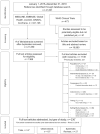Dietary Sodium Intake and Health Indicators: A Systematic Review of Published Literature between January 2015 and December 2019
- PMID: 32449929
- PMCID: PMC7490163
- DOI: 10.1093/advances/nmaa049
Dietary Sodium Intake and Health Indicators: A Systematic Review of Published Literature between January 2015 and December 2019
Abstract
As the science surrounding population sodium reduction evolves, monitoring and evaluating new studies on intake and health can help increase our understanding of the associated benefits and risks. Here we describe a systematic review of recent studies on sodium intake and health, examine the risk of bias (ROB) of selected studies, and provide direction for future research. Seven online databases were searched monthly from January 2015 to December 2019. We selected human studies that met specified population, intervention, comparison, outcome, time, setting/study design (PICOTS) criteria and abstracted attributes related to the study population, design, intervention, exposure, and outcomes, and evaluated ROB for the subset of studies on sodium intake and cardiovascular disease risks or indicators. Of 41,601 abstracts reviewed, 231 studies were identified that met the PICOTS criteria and ROB was assessed for 54 studies. One hundred and fifty-seven (68%) studies were observational and 161 (70%) focused on the general population. Five types of sodium interventions and a variety of urinary and dietary measurement methods were used to establish and quantify sodium intake. Five observational studies used multiple 24-h urine collections to assess sodium intake. Evidence mainly focused on cardiovascular-related indicators (48%) but encompassed an assortment of outcomes. Studies varied in ROB domains and 87% of studies evaluated were missing information on ≥1 domains. Two or more studies on each of 12 outcomes (e.g., cognition) not previously included in systematic reviews and 9 new studies at low ROB suggest the need for ongoing or updated systematic reviews of evidence on sodium intake and health. Summarizing evidence from assessments on sodium and health outcomes was limited by the various methods used to measure sodium intake and outcomes, as well as lack of details related to study design and conduct. In line with research recommendations identified by the National Academies of Science, future research is needed to identify and standardize methods for measuring sodium intake.
Keywords: cardiovascular health; dietary sodium; health indicators; reduction; risk of bias.
Published by Oxford University Press on behalf of the American Society for Nutrition 2020.
Figures



Similar articles
-
The future of Cochrane Neonatal.Early Hum Dev. 2020 Nov;150:105191. doi: 10.1016/j.earlhumdev.2020.105191. Epub 2020 Sep 12. Early Hum Dev. 2020. PMID: 33036834
-
Recovery schools for improving behavioral and academic outcomes among students in recovery from substance use disorders: a systematic review.Campbell Syst Rev. 2018 Oct 4;14(1):1-86. doi: 10.4073/csr.2018.9. eCollection 2018. Campbell Syst Rev. 2018. PMID: 37131375 Free PMC article.
-
Beyond the black stump: rapid reviews of health research issues affecting regional, rural and remote Australia.Med J Aust. 2020 Dec;213 Suppl 11:S3-S32.e1. doi: 10.5694/mja2.50881. Med J Aust. 2020. PMID: 33314144
-
Vitamin D and Calcium: A Systematic Review of Health Outcomes (Update).Evid Rep Technol Assess (Full Rep). 2014 Sep;(217):1-929. doi: 10.23970/AHRQEPCERTA217. Evid Rep Technol Assess (Full Rep). 2014. PMID: 30313003
-
Link Between Dietary Sodium Intake, Cognitive Function, and Dementia Risk in Middle-Aged and Older Adults: A Systematic Review.J Alzheimers Dis. 2020;76(4):1347-1373. doi: 10.3233/JAD-191339. J Alzheimers Dis. 2020. PMID: 32675410 Free PMC article.
Cited by
-
KDOQI US Commentary on the KDIGO 2020 Clinical Practice Guideline for Diabetes Management in CKD.Am J Kidney Dis. 2022 Apr;79(4):457-479. doi: 10.1053/j.ajkd.2021.09.010. Epub 2022 Feb 7. Am J Kidney Dis. 2022. PMID: 35144840 Free PMC article.
-
Dietary Adequacy in Older Adult Nursing Home Residents of the Northern Iberian Peninsula.Nutrients. 2024 Mar 11;16(6):798. doi: 10.3390/nu16060798. Nutrients. 2024. PMID: 38542709 Free PMC article.
References
-
- US Department of Health and Human Services (HHS) and USDA. 2015–2020 Dietary Guidelines for Americans. [Internet] 8th ed Washington (DC): US HHS and USDA; 2015; [accessed May 5, 2020]. Available from: http://health.gov/dietaryguidelines/2015/guidelines/.
-
- National Academies of Sciences, Engineering, and Medicine. Dietary Reference Intakes for sodium and potassium. Washington (DC): The National Academies Press; 2019. - PubMed
-
- Whelton PK, Carey RM, Aronow WS, Casey DE Jr, Collins KJ, Dennison Himmelfarb C, DePalma SM, Gidding S, Jamerson KA, Jones DW et al. .. 2017 ACC/AHA/AAPA/ABC/ACPM/AGS/APhA/ASH/ASPC/NMA/PCNA guideline for the prevention, detection, evaluation, and management of high blood pressure in adults: a report of the American College of Cardiology/American Heart Association Task Force on Clinical Practice Guidelines. Hypertension. 2018;71(6):e13–115. - PubMed
Publication types
MeSH terms
Substances
Grants and funding
LinkOut - more resources
Full Text Sources
Medical
Research Materials
Miscellaneous

